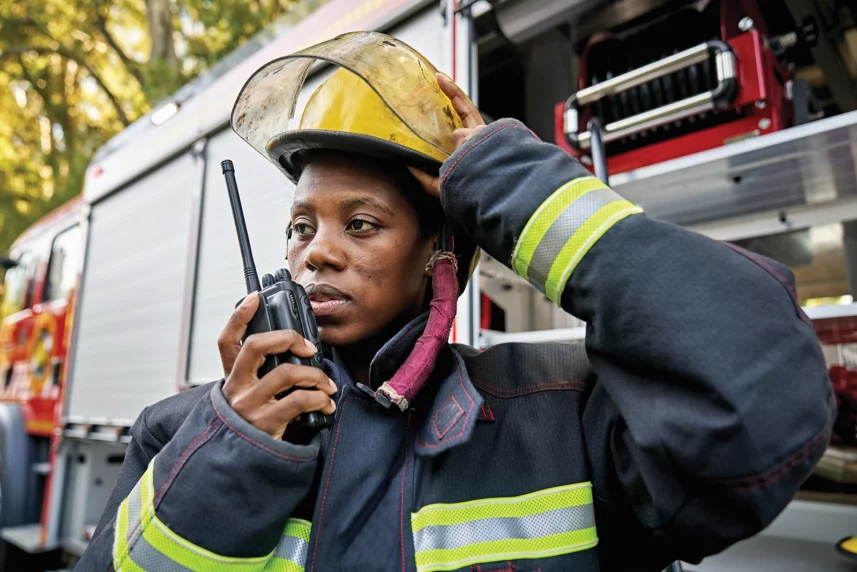Article:
BY ANITA B. STONE
Not a day goes by without a fire, automobile crash, chemical spill or other emergency involving firefighter intervention. Not one hour passes without someone needing urgent attention for a family crisis, weather-related trauma or hazardous cleanup somewhere in the U.S. Firefighters, EMS, police officers and other first responders must come to our aid at a moment’s notice. Yet in many states, including North Carolina, an ominous but less apparent emergency is facing these unsung heroes charged with protecting us and our communities.
This crisis primarily concerns a drastic loss of trained personnel to handle emergencies. According to a May 2020 Spectrum News report, the International Association of Fire Chiefs released information stating that budget cuts related to COVID-19 resulted in layoffs of at least 935 fire department employees in communities large and small across the U.S. This also reduced funds for equipment purchases, repair and maintenance needed for the firefighter’s safety.
Fire departments are still feeling the results of the personnel deficit and budget cuts. “We currently have 27 volunteers, but we need 35,” says Rolesville Fire Department Chief Donnie Lawrence, a 27-year firefighting veteran. “We are always looking for firefighters.”
Lawrence also mentioned his department’s need for equipment, such as large diameter hoses, and raised the issue of how crippling stress-related problems within the staff have led to vacancies. Other fire chiefs concur. “Firefighters and volunteers are leaving the profession,” says a fire chief who requested anonymity. “The quiet quitters just walk out,” he says. “This is dangerous work, long hours, and someone needs to be willing to pay our firefighters.”
Recruitment Woes
According to salary.com, indeed.com and glassdoor.com, the average annual salary for a firefighter in North Carolina is right around $49,000. This varies across the state since counties have widely varying tax bases.
Recruitment is further hampered by the obvious risks and higher level of training required to be a firefighter. “First, you have to get certified through a training program such as rookie school,” Lawrence explains. “Then there’s hazardous materials training, known as hazmat, and so on.” He added that there is an annual commitment of 36 hours yearly for training. Some states require emergency medical services training as well.
Stressors—sometimes severe—plaguing firefighters also inhibit recruitment and are the inevitable result of the landscapes in which these brave men and women work. The heat and constant danger of falling structural supports, smoke inhalation, ladder knowledge, and working face-to-face with distraught and injured citizens creates the need for a well-trained, capable squad. Post-traumatic stress disorder, depression, anxiety, and strain within the firefighter’s family also plague firefighting teams and can result in staff reductions.
Supply Chain Snags
Recent supply chain challenges add to firefighters’ frustrations. “The supply chain influences a firefighter’s job enormously,” says David Davis, a fire logistics specialist in the Wake Forest Fire Department’s Knox Homebox Program. “How do you think a firefighter feels following a rescue of 50 people from a burning building when he or she cannot even wear an identifying badge on a shirt because of a supply chain problem?” He also cited a motor on one fire truck they have not been able to fix for six months due to supply chain issues.
As if these stumbling blocks to recruitment weren’t enough, there may be more subtle influences at work. Aside from low pay, job stress, budget cuts and supply chain challenges, recruitment problems may also reflect changes in the attitude and life focus of younger generations. “Most volunteers have other activities, and the younger generation is so tuned into their Xbox and Playstation that it has hurt everyday life,” Lawrence says.
Flickers of Hope
Despite the multiplicity of pressures on today’s fire departments, there is some good news. According to a November 2022 WUNC report, Wake County Commissioners took steps toward addressing the exodus of firefighters by investing $2 million from the American Rescue Plan Act of 2021 toward firefighter recruitment. These efforts will target women and people of color, the biggest untapped pool of recruits. And for the first time, cadets in the training academy will be paid.
The National Volunteer Fire Council, a nonprofit membership association representing the interests of fire, EMS and rescue services, has introduced a program that offers support to firefighters, helping reduce the chance that they will leave the department when times get tough. The council’s Share The Load Program provides a 24-hour hotline answered by firefighters who are also trained counselors. They are able to provide additional resources for those callers dealing with depression and suicidal thoughts, among other issues.
The North Carolina Law Enforcement Assistance Program, a nonprofit and peer-run organization, aids firefighters and other first responders who have been involved in critical incidents. Recruits have plenty of choices for where to serve in Wake County. According to countyoffice.org, there are currently 90 fire departments in Wake County serving a population of over one million people in an area of 836 square miles. “Manpower is essential,” Lawrence says. “Last year alone, we had 1,198 calls for assistance.”
Lawrence welcomes anyone who would like to visit his fire department in Rolesville. “We would like our residents to know that the door is always open for volunteers and we want people to come by and visit with us to get a sense of helping out, which is very rewarding in its own way,” he says.


